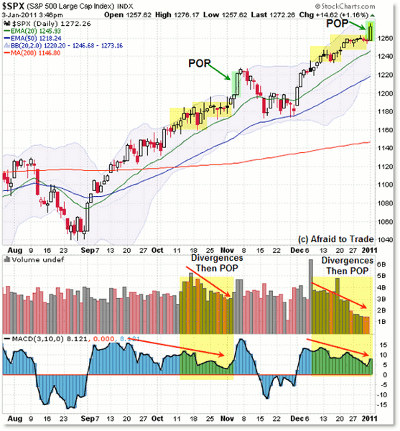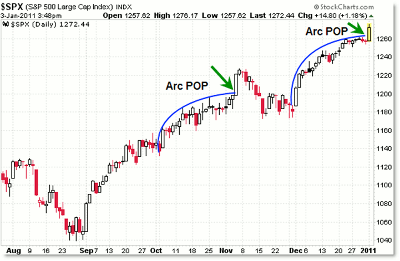It’s a common thing. New traders enter a trade because “The chart says it’s time,” only to find themselves stopped out when the market moves quickly in the opposite direction.
The S&P 500 has provided good lessons recently about why this happens.
Let’s take a look at the “repeating history” (you might be very surprised) and learn lessons from yet another excellent example of one of my favorite concepts: “Popped stops."
First, we’ll look at the overall structure of the SPX beginning 2011. I had a suspicion a big pop might happen, but it’s still sometimes surreal to see it happen first thing in the New Year!
Instead of a broad overview, I wanted to focus your attention on two things:
First, the popped stops single-day slaughter (for the bears) that occurred in early November and just repeated today.
Second, the price and divergence structure that preceded the pop, which served to trick the aggressive bears and pop them right out.
Let me do a brief overview of popped stops as it applies to the example above, a concept I discuss frequently in intraday summaries and in prior seminars/Webinars.
Generally, when price pushes up to a resistance level or the upper Bollinger band and divergences are present, aggressive short sellers go ahead and position ahead of an official entry signal, such as the breaking of a rising trend line or moving average (neither of which happened in either situation).
Condition one is that bears must be compelled/enticed by the charts to enter. Upon entering, they (usually) place stop losses (buy to cover) above their entries and a resistance level.
Condition two is that—for whatever reason—buyers/bulls ignore the divergences and press ahead buying anyway, which is a source of demand that overcomes the selling pressure of the bears.
Once bears enter and place stops, bulls buy to force price higher, and the bears then (you guessed it) buy to cover, thus locking in their losses.
This then often creates a short-term “positive feedback loop” wherein for a brief time, bulls are buying (to profit) and bears are buying (to limit losses).
To the extent that these two forces create more and more buying, the market will surge.
Usually it happens in a single day or over a few sessions, which gives the very aggressive trader (who understands this concept) a chance to profit from the feedback loop and the “crushing” of the short-term bears.
Article Continues on Page 2
|pagebreak|That being said, let's look at the nearly perfect repeat of history that gave clues that an upside explosion was on the table as a possibility, and today became reality.
Here is a “price-purism” view of the charts and the pattern repeat:
Generally—in fact, quite frequently—an overextended price swing that contains negative divergences tends to retrace sharply, if not reverse course entirely.
That’s the common and expected play, but the popped stops concept teaches one of my favorite quotes:
“If something should happen but does not, then it often leads to a larger-than-expected move in the opposite direction.”
The “larger-than-expected” move can be traded by aggressive, savvy traders. Others who are building experience should learn this concept and use it to limit losses and not fight a breakout move no matter how bearish (or bullish, if this situation was reversed in a downtrend) the charts look.
Positive feedback loops can be painful, and if you’re caught short and refuse to exit, you can lose a lot of money very quickly.
Rule number one, therefore, is to protect capital.
Rule number two, with experience, is to profit from these little pops in price.
One of the facts of technical analysis—and of trading in general—is that history repeats. Sometimes it repeats from one day to the next, but generally, patterns repeat.
It takes practice to see and classify the patterns (and I’m not necessarily talking about triangles or bull flags, though those are very common, repeating patterns, too) but structural patterns like this.
Anyway, take some time to study this example; how it developed, how bears were lured in, and then how they were forced to liquidate on the pre-market rally and throughout the morning session of the day, which gave sharp intraday traders a quick opportunity for some profits from the feedback loop.
By the way, if history continues to repeat, what happened after the pop in November was a little (expected) pullback.
Watch to see if that develops, and if not, then we’ll see even higher prices as more bears rush to cover.
I’ll be discussing more about trade execution tactics of patterns and structure in a presentation on “Trade Execution Tactics” at the New York Trader’s Expo, February 20-23, 2011.
I really enjoy the Expos, and traders of all experience levels can benefit from attending and networking. I hope you can join us all there!
By Corey Rosenbloom, trader and blogger, AfraidToTrade.com























